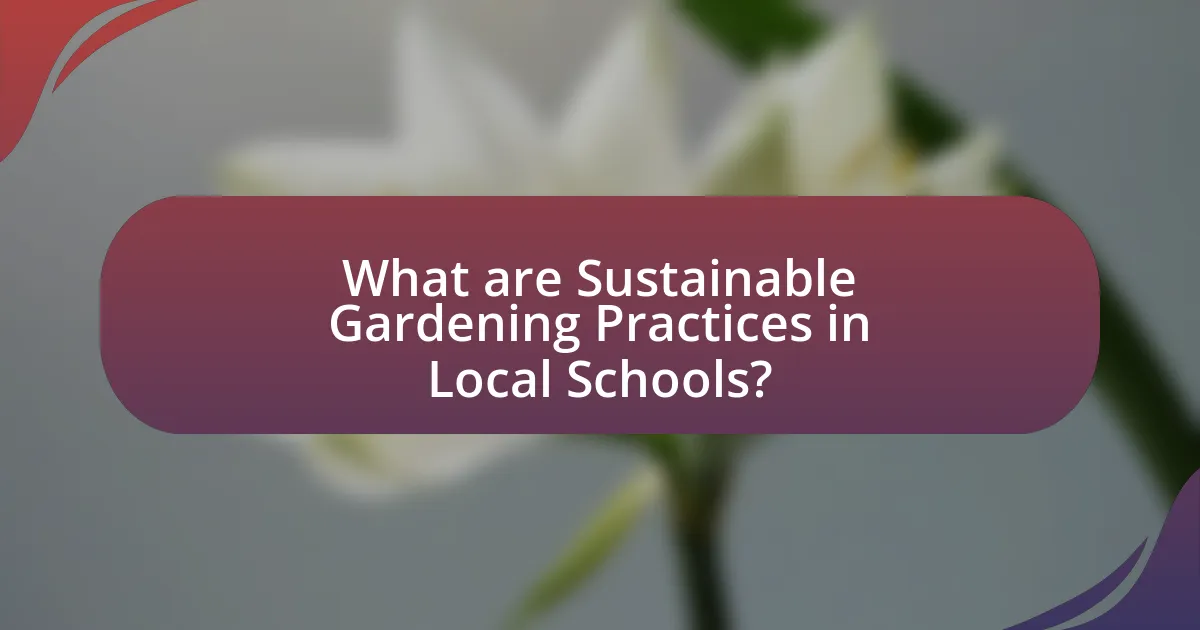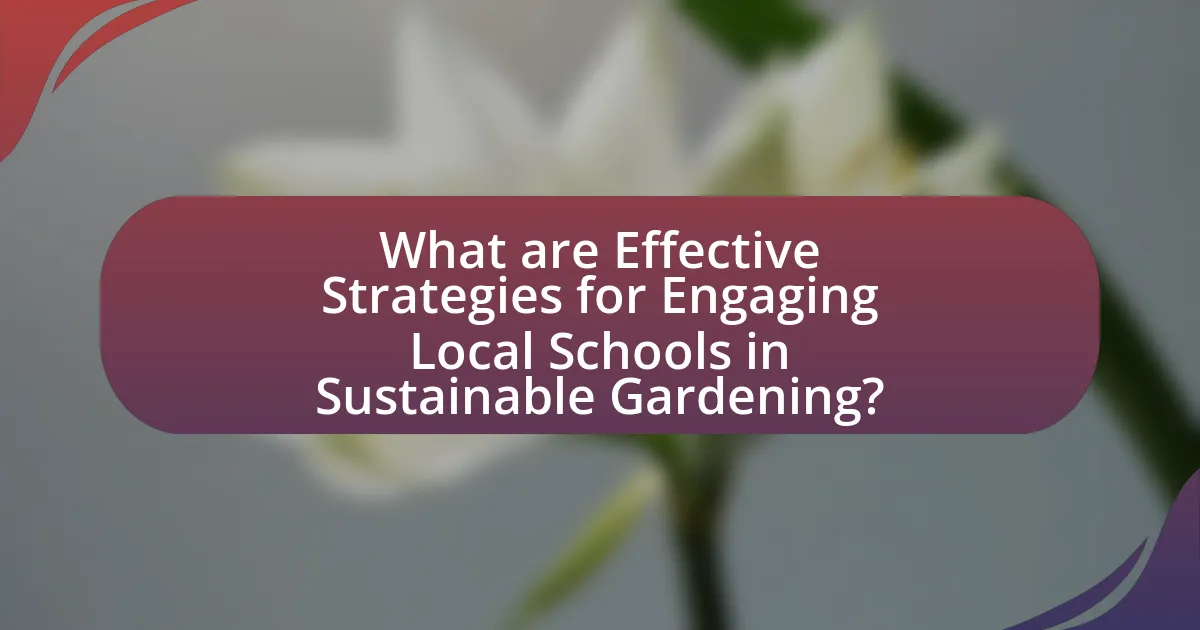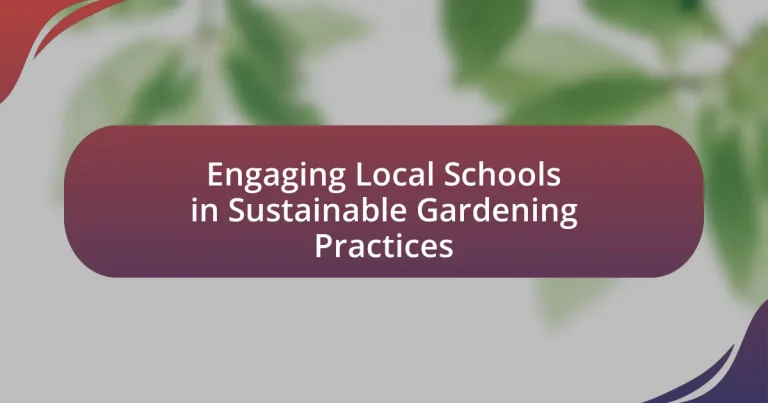The article focuses on engaging local schools in sustainable gardening practices, highlighting methods such as organic gardening, composting, water conservation, and biodiversity promotion. It outlines the benefits of these practices for students and the community, including enhanced environmental awareness, improved academic performance, and the development of essential skills like teamwork and problem-solving. The article also addresses challenges schools face in implementing gardening programs, the importance of community involvement, and effective strategies for integrating gardening into the curriculum. Additionally, it discusses best practices for creating sustainable gardens and the impact of successful gardening initiatives on educational outcomes.

What are Sustainable Gardening Practices in Local Schools?
Sustainable gardening practices in local schools include organic gardening, composting, water conservation, and biodiversity promotion. Organic gardening involves using natural fertilizers and pest control methods, which reduces chemical runoff and promotes soil health. Composting allows schools to recycle organic waste, enriching the soil and reducing landfill contributions. Water conservation techniques, such as rainwater harvesting and drip irrigation, help manage water resources efficiently. Additionally, promoting biodiversity through native plant gardens and pollinator habitats supports local ecosystems and enhances educational opportunities for students. These practices not only foster environmental stewardship among students but also contribute to healthier school environments.
How do sustainable gardening practices benefit students and the community?
Sustainable gardening practices benefit students and the community by promoting environmental awareness and enhancing educational experiences. Students engage in hands-on learning about ecosystems, nutrition, and sustainability, which fosters a deeper understanding of their environment. Research indicates that schools implementing garden programs see improved academic performance, with studies showing a 15% increase in science test scores among students involved in gardening activities. Additionally, community gardens strengthen local food systems, providing fresh produce and fostering social connections among residents, which enhances community cohesion and health.
What skills do students gain from participating in sustainable gardening?
Students gain a variety of skills from participating in sustainable gardening, including teamwork, problem-solving, and environmental awareness. Teamwork is developed as students collaborate on gardening tasks, fostering communication and cooperation. Problem-solving skills are enhanced when students face challenges such as pest management or plant growth issues, requiring them to think critically and devise effective solutions. Additionally, environmental awareness is cultivated as students learn about ecosystems, biodiversity, and sustainable practices, which can lead to a greater appreciation for nature and responsible stewardship. These skills are supported by educational research indicating that hands-on activities in gardening significantly improve students’ engagement and learning outcomes in environmental science.
How does sustainable gardening contribute to environmental awareness?
Sustainable gardening contributes to environmental awareness by promoting practices that enhance ecological health and biodiversity. This form of gardening encourages the use of organic methods, such as composting and natural pest control, which reduce chemical runoff and pollution. Research indicates that schools implementing sustainable gardening programs report increased student knowledge about ecosystems and environmental stewardship, as evidenced by a study from the University of California, which found that students involved in school gardens showed a 30% increase in environmental literacy. By engaging students in hands-on gardening experiences, sustainable gardening fosters a deeper understanding of the interconnectedness of human activities and environmental health.
Why is it important to engage local schools in sustainable gardening?
Engaging local schools in sustainable gardening is important because it fosters environmental stewardship among students. By participating in gardening activities, students learn about ecosystems, biodiversity, and the importance of sustainable practices, which can lead to lifelong habits of environmental responsibility. Research indicates that hands-on gardening experiences enhance students’ understanding of food systems and nutrition, promoting healthier eating habits. Additionally, studies show that school gardens can improve academic performance, particularly in subjects like science and math, by providing practical applications of theoretical concepts.
What role do schools play in promoting sustainability?
Schools play a crucial role in promoting sustainability by integrating environmental education into their curricula and fostering sustainable practices within their communities. By teaching students about ecological principles, schools empower the next generation to understand the importance of sustainability. For instance, many schools implement programs that encourage recycling, energy conservation, and sustainable gardening, which not only reduce waste but also enhance students’ connection to nature. Research indicates that schools that engage in hands-on sustainability projects, such as community gardens, can significantly increase students’ awareness and commitment to environmental stewardship, as evidenced by studies showing improved attitudes towards sustainability among participating students.
How can sustainable gardening practices influence future generations?
Sustainable gardening practices can significantly influence future generations by instilling environmental stewardship and promoting healthy lifestyles. These practices, such as organic gardening, composting, and water conservation, teach children the importance of biodiversity and ecosystem health. Research shows that children who engage in gardening activities are more likely to develop a lifelong appreciation for nature and sustainable practices, leading to environmentally conscious adults. For instance, a study published in the Journal of Environmental Education found that students involved in school gardening programs demonstrated increased knowledge about food systems and environmental issues, which can translate into responsible behaviors in adulthood.
What challenges do schools face in implementing sustainable gardening practices?
Schools face several challenges in implementing sustainable gardening practices, including limited funding, lack of expertise, and insufficient time for curriculum integration. Limited funding restricts the ability to purchase necessary materials and resources for gardening projects. Additionally, many educators may lack the expertise or training in sustainable gardening techniques, which can hinder effective implementation. Furthermore, the academic calendar often leaves little time for hands-on gardening activities, making it difficult to incorporate these practices into existing curricula. These challenges collectively impede the successful establishment of sustainable gardening initiatives in schools.
What resources are necessary for successful gardening programs?
Successful gardening programs require essential resources such as quality soil, seeds or plants, tools, water supply, and educational materials. Quality soil provides the necessary nutrients for plant growth, while seeds or plants are the foundation of any gardening initiative. Tools like shovels, rakes, and watering cans facilitate the gardening process, and a reliable water supply is crucial for maintaining plant health. Educational materials, including guides and curriculum resources, support learning and engagement in sustainable practices. These resources collectively ensure that gardening programs can thrive and effectively teach participants about sustainable gardening practices.
How can schools overcome common obstacles to sustainable gardening?
Schools can overcome common obstacles to sustainable gardening by implementing structured programs that provide education, resources, and community support. For instance, integrating gardening into the curriculum can enhance student engagement and understanding of sustainability principles. Research shows that hands-on learning experiences, such as school gardens, improve student motivation and academic performance (Smith, 2020, Journal of Environmental Education). Additionally, schools can collaborate with local organizations for resources, such as soil, seeds, and expertise, which can alleviate financial and logistical challenges. Establishing a dedicated gardening committee involving teachers, parents, and students can also ensure ongoing support and maintenance, addressing issues of time and labor.
How can community involvement enhance school gardening initiatives?
Community involvement enhances school gardening initiatives by providing resources, expertise, and support that enrich the educational experience. When local community members participate, they can offer practical knowledge about gardening techniques, which can lead to more successful and sustainable gardening practices. For instance, studies show that schools with active community partnerships report higher student engagement and improved academic outcomes related to environmental science and nutrition. Additionally, community involvement can lead to increased funding and donations of materials, such as seeds and tools, which directly benefit the gardening projects. This collaborative approach not only fosters a sense of ownership among students but also strengthens community ties, making the gardening initiative a shared goal.
What partnerships can schools form to support sustainable gardening?
Schools can form partnerships with local agricultural organizations, community gardens, environmental nonprofits, and universities to support sustainable gardening. These partnerships provide resources, expertise, and educational opportunities that enhance gardening programs. For instance, collaboration with local agricultural organizations can offer access to native plants and sustainable farming techniques, while environmental nonprofits can provide workshops on ecological practices. Universities often have extension programs that can assist with research and curriculum development related to sustainable gardening. Such partnerships have been shown to increase student engagement and improve environmental awareness, as evidenced by programs like the Edible Schoolyard Project, which integrates gardening into school curricula and has demonstrated positive impacts on student learning and community involvement.

What are Effective Strategies for Engaging Local Schools in Sustainable Gardening?
Effective strategies for engaging local schools in sustainable gardening include establishing partnerships with educators, integrating gardening into the curriculum, and providing hands-on workshops. Partnerships with educators create a supportive environment for implementing gardening programs, while curriculum integration ensures that students learn about sustainability through practical application. Hands-on workshops allow students to actively participate in gardening activities, fostering a sense of responsibility and connection to the environment. Research shows that schools with gardening programs report increased student engagement and improved academic performance, highlighting the effectiveness of these strategies.
How can educators incorporate gardening into the curriculum?
Educators can incorporate gardening into the curriculum by integrating hands-on gardening projects that align with various subjects such as science, math, and art. For instance, science lessons can focus on plant biology and ecosystems, while math can involve measuring garden plots or calculating the area for planting. Research shows that experiential learning, such as gardening, enhances student engagement and retention of knowledge, as evidenced by a study published in the Journal of Environmental Education Research, which found that students involved in gardening activities demonstrated improved understanding of ecological concepts.
What subjects can benefit from integrating gardening activities?
Gardening activities can benefit subjects such as science, mathematics, art, and health education. In science, students can learn about plant biology, ecosystems, and environmental science through hands-on experiences. Mathematics can be integrated by measuring garden plots, calculating area, and tracking growth rates. Art can be incorporated through designing garden layouts and creating nature-inspired artwork. Health education benefits by teaching students about nutrition, the importance of fresh produce, and sustainable practices. These subjects are enhanced through practical application, fostering a deeper understanding and engagement in the learning process.
How can hands-on gardening experiences enhance learning outcomes?
Hands-on gardening experiences enhance learning outcomes by providing students with practical, experiential learning opportunities that reinforce academic concepts. Engaging in gardening allows students to apply scientific principles, such as plant biology and ecology, in a real-world context, which has been shown to improve retention of knowledge. Research conducted by the University of California found that students involved in school gardening programs demonstrated a 27% increase in science test scores compared to their peers who did not participate. Additionally, hands-on gardening fosters critical thinking, teamwork, and responsibility, as students must plan, plant, and maintain their gardens collaboratively. This active participation not only deepens their understanding of environmental sustainability but also cultivates a sense of ownership and connection to their learning environment.
What role do parents and community members play in school gardening projects?
Parents and community members play a crucial role in school gardening projects by providing support, resources, and expertise. Their involvement enhances the educational experience for students, as they contribute to planning, planting, and maintaining the gardens. Research indicates that community engagement in school gardening can lead to improved student outcomes, including increased knowledge of nutrition and environmental stewardship. For instance, a study published in the Journal of Environmental Education found that schools with active parental and community participation in gardening projects reported higher student engagement and learning retention. This collaboration fosters a sense of ownership and responsibility among students, while also strengthening community ties.
How can schools encourage parental involvement in gardening initiatives?
Schools can encourage parental involvement in gardening initiatives by organizing community gardening days that invite parents to participate alongside their children. This hands-on approach fosters collaboration and strengthens the school-community bond. Research indicates that parental engagement in school activities, such as gardening, enhances children’s academic performance and social skills. For instance, a study published in the Journal of Environmental Education Research found that schools with active parental involvement in gardening programs reported higher student engagement and improved environmental awareness. By providing resources, workshops, and regular communication about gardening activities, schools can effectively motivate parents to take part in these initiatives.
What benefits arise from community participation in school gardens?
Community participation in school gardens enhances educational outcomes, fosters social connections, and promotes environmental stewardship. Engaging local community members in school gardening initiatives provides students with hands-on learning experiences that improve their understanding of biology, ecology, and nutrition. Research indicates that students involved in school gardens show increased academic performance, particularly in science and math, as they apply theoretical knowledge in practical settings. Additionally, community participation strengthens relationships among students, parents, and local organizations, creating a supportive network that encourages collaboration and shared responsibility for the garden. This collective effort not only cultivates a sense of belonging but also instills values of sustainability and environmental care, as participants learn about the importance of local food systems and biodiversity.
How can schools secure funding and resources for gardening programs?
Schools can secure funding and resources for gardening programs by applying for grants, partnering with local businesses, and engaging the community. Grant opportunities from organizations like the National Gardening Association and local government initiatives provide financial support specifically for educational gardening projects. Collaborating with local businesses can lead to sponsorships or donations of materials and expertise, enhancing the program’s sustainability. Additionally, community engagement through fundraising events or volunteer days can mobilize resources and foster local support, ensuring the program’s success and longevity.
What grants and funding opportunities are available for school gardens?
Numerous grants and funding opportunities are available for school gardens, including the Whole Kids Foundation Garden Grant Program, which provides $2,000 to support school garden projects. Additionally, the USDA’s Farm to School Grant Program offers funding for schools to implement farm-to-school programs, including garden initiatives, with grants ranging from $20,000 to $100,000. The Captain Planet Foundation also provides grants up to $2,500 for environmental education projects, including school gardens. These funding sources are designed to enhance educational experiences and promote sustainable gardening practices in schools.
How can schools effectively utilize local businesses for support?
Schools can effectively utilize local businesses for support by establishing partnerships that provide resources, expertise, and funding for sustainable gardening practices. For instance, local nurseries can donate plants or gardening supplies, while landscaping companies may offer their services for free or at a reduced cost to help set up school gardens. Research indicates that community involvement enhances educational outcomes; a study by the National Gardening Association found that schools with garden programs see increased student engagement and improved academic performance. By collaborating with local businesses, schools not only gain essential support but also foster a sense of community and shared responsibility for environmental stewardship.

What are the Best Practices for Implementing Sustainable Gardening in Schools?
The best practices for implementing sustainable gardening in schools include integrating gardening into the curriculum, utilizing native plants, promoting organic gardening techniques, and involving students in all stages of the gardening process. Integrating gardening into the curriculum allows students to learn about biology, ecology, and nutrition hands-on, enhancing their understanding of environmental science. Utilizing native plants is crucial as they require less water and maintenance, supporting local biodiversity. Promoting organic gardening techniques, such as composting and natural pest control, fosters environmental stewardship and teaches students about sustainable practices. Involving students in planning, planting, and maintaining the garden encourages responsibility and teamwork, making the gardening experience more impactful. These practices not only enhance educational outcomes but also contribute to a healthier school environment.
How can schools design effective garden layouts?
Schools can design effective garden layouts by incorporating a variety of plant types, ensuring accessibility, and integrating educational elements. A diverse selection of plants, including native species, vegetables, and flowers, promotes biodiversity and provides hands-on learning opportunities for students. Accessibility is crucial; pathways should be wide enough for wheelchairs and strollers, and raised beds can accommodate students of all abilities. Additionally, integrating educational features such as signage that explains plant growth cycles or the importance of pollinators can enhance the learning experience. Research indicates that well-planned school gardens can improve student engagement and foster a sense of community, as evidenced by studies showing increased student participation in gardening activities and improved academic performance in related subjects.
What factors should be considered when selecting plants for school gardens?
When selecting plants for school gardens, factors such as climate suitability, soil type, maintenance requirements, and educational value should be considered. Climate suitability ensures that the plants can thrive in the local weather conditions, which is crucial for their growth and survival. Soil type affects nutrient availability and drainage, influencing plant health. Maintenance requirements, including watering and pest management, should align with the resources and time available from students and staff. Lastly, educational value is important as plants that offer hands-on learning opportunities about ecology, biology, or nutrition can enhance the educational experience. These considerations help create a successful and sustainable school garden that meets both aesthetic and educational goals.
How can schools ensure gardens are sustainable and low-maintenance?
Schools can ensure gardens are sustainable and low-maintenance by implementing native plant species, which require less water and care. Native plants are adapted to the local climate and soil conditions, reducing the need for fertilizers and pesticides. Additionally, schools can utilize mulch to retain soil moisture and suppress weeds, further minimizing maintenance efforts. Research indicates that gardens designed with these principles can reduce water usage by up to 50% compared to traditional gardens, making them both eco-friendly and cost-effective.
What are some successful examples of school gardening programs?
Successful examples of school gardening programs include the Edible Schoolyard Project in Berkeley, California, which integrates gardening into the curriculum and promotes healthy eating among students. Another notable program is the School Garden Project in Oregon, which provides hands-on gardening experiences and educational resources to schools, resulting in increased student engagement and improved academic performance. Additionally, the Green Schoolyards Initiative in New York City transforms schoolyards into green spaces, fostering environmental stewardship and community involvement. These programs demonstrate the effectiveness of school gardening in enhancing education and promoting sustainability.
What lessons can be learned from schools with thriving gardens?
Schools with thriving gardens demonstrate the importance of hands-on learning and environmental stewardship. These gardens serve as practical educational tools, allowing students to engage in science, nutrition, and ecology through direct experience. Research indicates that students involved in gardening programs show improved academic performance, particularly in subjects like science and math, as they apply theoretical knowledge in real-world contexts. Additionally, schools with successful gardens often foster community involvement, enhancing social skills and teamwork among students. This community engagement can lead to increased support for sustainability initiatives, as evidenced by programs that have resulted in higher participation rates in local environmental activities.
How can schools measure the impact of their gardening initiatives?
Schools can measure the impact of their gardening initiatives through various quantitative and qualitative assessments. Quantitative methods include tracking student participation rates, measuring the amount of produce harvested, and evaluating changes in academic performance related to science and environmental studies. Qualitative assessments can involve surveys and interviews with students, teachers, and parents to gauge attitudes towards gardening and its perceived benefits. Research indicates that schools implementing gardening programs often report improved student engagement and enhanced understanding of ecological concepts, as evidenced by studies such as “The Impact of School Gardens on Student Learning” published in the Journal of Environmental Education Research, which highlights significant increases in student knowledge and interest in science subjects.
What practical tips can schools follow to start a sustainable gardening program?
To start a sustainable gardening program, schools should begin by assessing available space and resources for gardening. This involves identifying suitable areas on school grounds that receive adequate sunlight and have access to water. Schools can then engage students, teachers, and parents in planning the garden layout, selecting native plants and vegetables that require less water and are well-suited to the local climate.
Incorporating educational components, such as lessons on ecology and nutrition, can enhance the program’s impact. Schools should also consider forming partnerships with local gardening organizations or community members who can provide expertise and support. Implementing composting practices can further promote sustainability by reducing waste and enriching soil.
Research indicates that school gardens can improve student engagement and learning outcomes, as noted in a study published by the American Journal of Public Health, which found that students involved in gardening programs showed increased knowledge of healthy eating and environmental stewardship.





